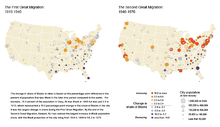Second Great Migration (African American)

In the context of the 20th-century history of the United States, the Second Great Migration was the migration of more than five million African Americans from the South to the North, Midwest and West. It took place from 1941, through World War II, and lasted until 1970.[1] It was much larger and of a different character than the first Great Migration (1910–1940).
In the Second Great Migration, more than five million African Americans moved to cities in states in the North, Midwest and West, including many to California, where Los Angeles, Oakland, and Long Beach offered many skilled jobs in the defense industry. Most of these migrants were already urban laborers who came from the cities of the South. In addition, some African Americans were still treated with discrimination in many parts of the country, and many sought to escape this.[1]
Urban settlement
Compared to the more rural migrants of the period 1910-1930, many African Americans in the South were already living in urban areas and had urban job skills before they relocated. They moved to take jobs in the burgeoning industrial cities and especially the many jobs in the defense industry during World War II (WWII). Workers who were limited to segregated, low-skilled jobs in some cities were able to get highly skilled, well-paid jobs at California shipyards.[1]
By the end of the Second Great Migration, African Americans had become a highly urbanized population. More than 80 percent lived in cities, a greater proportion than among the rest of American society. Fifty-three percent remained in the Southern United States, while 40 percent lived in the Northeast and North Central states and 7 percent in the West.[1]
While African Americans were often relegated to support roles during WWII, often these roles could be exceedingly hazardous. A munitions explosion at Port Chicago, California, across the bay from San Francisco, claimed the lives of over 200 African Americans in 1944. When some of the workers refused to resume work until conditions were made less hazardous, as many as 50 were tried for mutiny and imprisoned.[2]
Other effects of the Second Great Migration:
- Demographic changes in losing and gaining states;
- African Americans became more unionized they became known as the churches and ministers.
- African Americans developed original religions and Christian movements, such as the Nation of Islam and predominantly-black dominations within the Pentecostal movement
Statistics
| Region | 1900 | 1910 | 1920 | 1930 | 1940 | 1950 | 1960 | 1970 |
|---|---|---|---|---|---|---|---|---|
| Northeast | 1.8% | 1.9% | 2.3% | 3.3% | 3.8% | 5.1% | 6.8% | 8.8% |
| Midwest | 1.9% | 1.8% | 2.3% | 3.3% | 3.5% | 5.0% | 6.7% | 8.1% |
| West | 0.7% | 0.7% | 0.9% | 1.0% | 1.2% | 2.9% | 3.9% | 4.9% |
| South | 32.3% | 29.8% | 26.9% | 24.7% | 23.8% | 21.7% | 20.6% | 19.0% |
See also
References
- ↑ 1.0 1.1 1.2 1.3 "In Motion: African American Migration Experience, The Second Great Migration". Retrieved 2007-03-18.
- ↑ "Explosion and Mutiny at Port Chicago", National Park Service
- ↑ Gibson, Campbell; Kay Jung (September 2002). Historical Census Statistics on Population Totals By Race, 1790 to 1990, and By Hispanic Origin, 1970 to 1990, For The United States, Regions, Divisions, and States. Working Paper Series No. 56. Washington, DC: Population Division, U. S. Census Bureau. Retrieved 2013-05-21.
Further reading
- Arnesen, Eric. Black Protest and the Great Migration: A Brief History with Documents (2002).
- Gregory, James. The Southern Diaspora: How the Great Migrations of Black and White Southerners Transformed America. (University of North Carolina Press, 2005).
- Grossman, James R. Land of Hope: Chicago, Black Southerners, and the Great Migration (1991).
- Lemann, Nicholas. The Promised Land: The Great Black Migration and How It Changed America (1991)
- Sernett, Milton. Bound for the Promised Land: African Americans' Religion and the Great Migration (1997).
- Wilkerson, Isabel. The Warmth of Other Suns: The Epic Story of America's Great Migration (Random House, 2010) 640pp; based on over 1000 interviews; ISBN 978-0-679-44432-9
External links
| ||||||||||||||